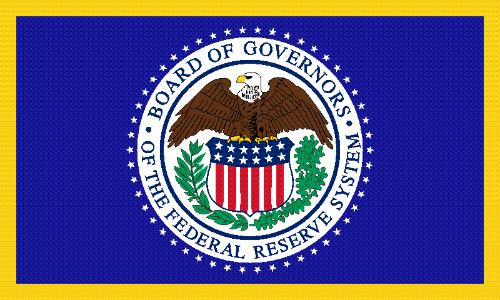Something about the Federal Reserve
美联储的台前幕后
The Federal Reserve System (also known as the Federal Reserve, and informally as the Fed) is the central banking system of the United States. It was created in 1913 by the enactment of the Federal Reserve Act, largely as a response to a series of financial panics or bank runs, particularly a severe panic in 1907. Over time,the roles and responsibilities of the Federal Reserve System have expanded and its structure has evolved. Events such as the Great Depression were some of the major factors leading to changes in the system. Its duties today, according to official Federal Reserve documentation, fall into four general areas:
联邦储备系统(人们常说的美联储)是美国的中央银行系统。该系统于1913年根据美国的联邦储备法案而建立,主要用于应对一系列的金融恐慌和银行挤兑,特别是在1907年发生的严重的金融恐慌。随着时间的推移,美联储的职责也得到了扩大并且其结构也已经改进。像30年代大萧条这样的事件是促使系统改变的主要因素。美联储如今的职责,根据官方的联邦储备文件规定,可以分为以下4个大部分:
1. Conducting the nation’s monetary policy by influencing the monetary and credit conditions in the economy in pursuit of maximum employment, stable prices, and moderate long-term interest rates.
1. 执行国家的货币政策,通过改变经济的货币及信用情况以求最大程度地增加就业率,保持物价稳定和长期稳定的利率。
2. Supervising and regulating banking institutions to ensure the safety and soundness of the nation's banking and financial system and to protect the credit rights of consumers.
2. 对银行机构进行监管和规范,以保证国家银行业和金融系统的安全和稳定,并保护消费者的信用权利。
3. Maintaining the stability of the financial system and containing systemic risk that may arise in financial markets.
3. 保持金融系统的稳定以及控制可能在金融市场出现的系统性风险。
4. Providing financial services to depository institutions,the US government, and foreign official institutions, including playing a major role in operating the nation’s payments system.
4. 向美国政府和国外的官方机构等储蓄机构提供金融服务,包括在国家支付系统的经营中扮演主要角色。

The Federal Reserve is regarded as a quasi-public banking system, since it has aspects of both a government run system and private enterprise. According to the Federal Reserve, there are presently five different parts of the Federal Reserve System:
美联储被认为是一个私营的公共银行系统,因为它即拥有政府运营的部分又有私人企业管理的部分。就美联储而言,主要可以分为5个不同部门:
1. The presidentially appointed Board of Governors of the Federal Reserve System, a governmental agency in Washington D.C.
1. 由总统直接任命的联邦储备委员会,这是位于华盛顿特区的政府机关。
2. The Federal Open Market Committee (FOMC), which oversees Open Market Operations, the principal tool of national monetary policy.
2. 联邦公开市场委员会,负责监管公开市场的操作,是国家货币政策的主要工具。
3. Twelve regional privately-owned Federal Reserve Banks located in major cities throughout the nation, which divide the nation into 12 districts, acting as fiscal agents for the US Treasury, each with its own nine-member board of directors.
3. 12个分布在全国主要城市的私有联储分行将美国分为12 区,每个分行都有9个理事会委员,其职能为美国的财政中介。
4. Numerous other private US member banks, which subscribe to required amounts of nontransferable stock in their regional Federal Reserve Banks.
4. 众多的其他美国私人银行,其中每家银行须向当地的美联储分行捐赠规定数额的非转移性股票。
5. Various advisory councils.
5. 各种咨询委员会。
The structure of the central banking system in the United States is unique compared to others’ in the world, in that an entity outside of the central bank creates the currency. This other entity is the United States Department of the Treasury.
美国中央银行体系的构造相较于其他国家的而言是非常独特的,因为独立于中央银行之外还有一个制造货币的机构,那就是美国的财政部。
Under the dollar reserve standard, the US dollar was the most favored currency for nations of the world to use as reserves, which continued as dollar reserve standard, the 1970s became a period of high inflation. As a result, in July 1979 Paul Volcker was nominated by President Carter as Chairman of the Federal Reserve Board. He tightened the money supply, and by 1986 inflation had fallen sharply. In October 1979 the Federal Reserve announced a policy of "targeting" money aggregates and bank reserves in its struggle with double-digit inflation.
在美元储备标准之下,美元曾经在全球各地最受欢迎的储备货币,并且这一趋势持续了30多年。在美元储备标准建立之初,20世纪70年代成为了通货膨胀较严重的一段时期。因此,1979年7月总统卡特任命保罗·沃尔克为联邦储备委员会主席。他紧缩了货币的供应,到1986年通货膨胀率急剧下降。1979年10月,美联储宣布一项“目标”资金总量政策并且银行储备系统也在两位数的通货膨胀率下苦苦挣扎。













